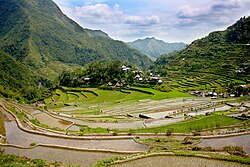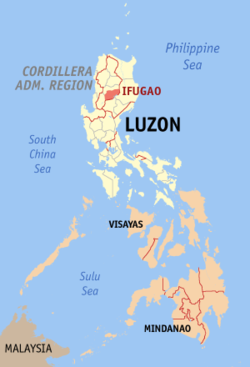Ifugao
| Ifugao | |||
|---|---|---|---|
| Province | |||
| Province of Ifugao | |||

|
|||
|
|||
 Location in the Philippines |
|||
| Coordinates: 16°50′N 121°10′E / 16.83°N 121.17°ECoordinates: 16°50′N 121°10′E / 16.83°N 121.17°E | |||
| Country | Philippines | ||
| Region | Cordillera Administrative Region (CAR) | ||
| Founded | June 18, 1966 | ||
| Capital | Lagawe | ||
| Government | |||
| • Type | Sangguniang Panlalawigan | ||
| • Governor | Pedro Mayam-o (PDP–Laban) | ||
| • Vice Governor | Jordan Gullitiw (LP) | ||
| Area | |||
| • Total | 2,628.21 km2 (1,014.76 sq mi) | ||
| Area rank | 50th out of 81 | ||
| Population (2015 census) | |||
| • Total | 202,802 | ||
| • Rank | 72nd out of 81 | ||
| • Density | 77/km2 (200/sq mi) | ||
| • Density rank | 74th out of 81 | ||
| Divisions | |||
| • Independent cities | 0 | ||
| • Component cities | 0 | ||
| • Municipalities |
11
|
||
| • Barangays | 175 | ||
| • Districts | Lone district of Ifugao | ||
| Time zone | PHT (UTC+8) | ||
| ZIP code | 3600–3610 | ||
| IDD : area code | +63 (0)74 | ||
| ISO 3166 code | PH-IFU | ||
| Spoken languages | |||
Ifugao (Ilocano: Probinsya ti Ifugao; Filipino: Lalawigan ng Ifugao) is a landlocked province of the Philippines in the Cordillera Administrative Region in Luzon. Its capital is Lagawe and it borders Benguet to the west, Mountain Province to the north, Isabela to the east, and Nueva Vizcaya to the south.
The Rice Terraces of the Philippine Cordilleras and Banaue Rice Terraces are the main tourist attractions in the province. These terraces were hand-carved into the mountains 2,000 years ago to plant rice. In 1995, they were declared as a UNESCO World Heritage Site.
Ifugao is named after the term i-pugo ("i" [from/people] and pugo [hill]), which translates to people of the hill.
Prior to colonization, Ifugao was a massive highland plutocracy, among the most sophisticated and prosperous of its kind in the whole archipelago and one of the two grandest highland plutocracies in Luzon, the other being the Plutocracy of Kalinga. The state existed for over 2,000 years and have built massive rice terraces that would be a symbol of the province in later time. There were no monarchs in the state. The state was ruled by its council of elders which led the state into a peaceful and prosperous plutocracy which developed one of the best agricultural technologies in Asia at its time. The state consisted of various subgroups which had similar yet somewhat distinct culture and traditions. Conflicts among the Ifugao people were resolved in the most peaceful way possible. Unlike most of the highland plutocracies in the Cordilleras at the time, the Plutocracy of Ifugao had the least conflict with lowland settlers or Ilokanos. Kiangan was known as the birthplace of the Ifugao people and Hungduan as the epicenter of its culture.
...
Wikipedia


